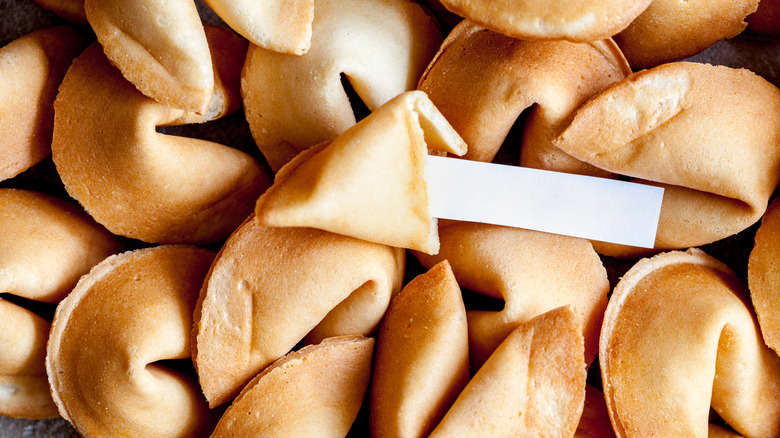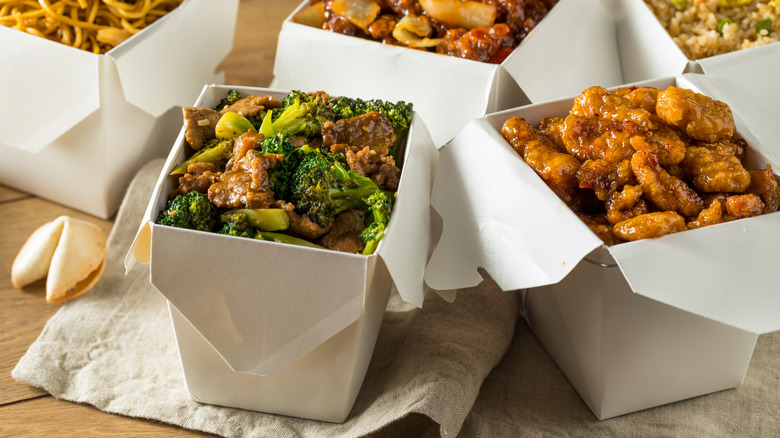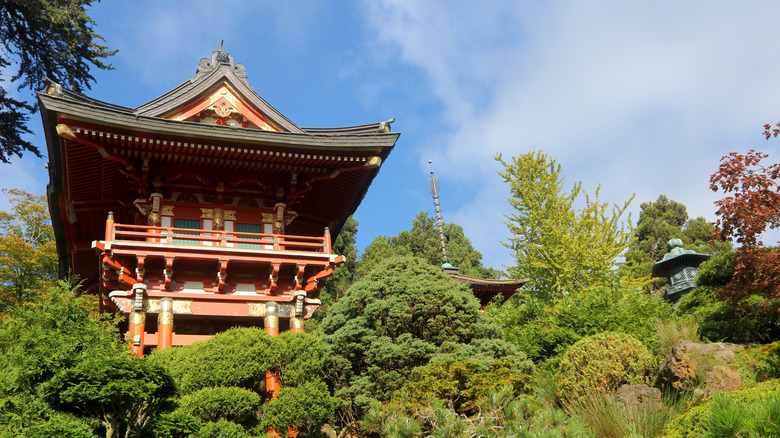Ever Wonder Who Invented Fortune Cookies?
Whether you're dining in on nostalgic chop suey or enjoying some takeout chow mein or lo mein, a restaurant-prepared Chinese meal in the United States almost always concludes with the crisp snap of a crunchy vanilla-flavored cookie, revealing a small paper slip with prophetic text inside. Fortune cookies are synonymous with Chinese cuisine in the U.S., yet the origin story of the modern fortune cookie isn't actually tied to China.
While some aspects of China's culinary history to the evolution of the fortune cookie — like 14th-century moon cakes containing hidden messages — the fortune cookies we know today trace their roots back to Japanese culture. In the late 1800s, shops in Japan began selling folded fortune-filled savory crackers known as tsujiura senbei. As Japanese immigrants arrived on the west coast of the United States, these crackers came with them.
By the early 1900s, Japanese immigrant Makoto Hagiwara was serving these savory crackers at the Japanese Tea Garden in Golden Gate Park. However, producing enough of these treats by hand became a challenge, so he enlisted the help of another Japanese immigrant, confectioner Suyeichi Okamura. Okamura agreed to produce the snacks for Hagiwara and, with American flavor preferences in mind, altered the recipe to be sweet, creating what we now recognize as fortune cookies.
How did fortune cookies become associated with Chinese food?
For decades, Suyeichi Okamura continued to make fortune cookies at Benkyodo for the Japanese Tea Garden, and other makers began producing the cookies as well. In fact, a dispute arose over who had first created the cookie, with David Jung, owner of Hong Kong Noodle Company in Los Angeles, claiming the invention. However, this was later debunked, with San Francisco's Court of Historical Review providing evidence that the Japanese Tea Garden was the first to serve it.
In early 1942, the production and sale of fortune cookies by Japanese Americans came to a halt. Following President Franklin D. Roosevelt's executive order, Japanese Americans were forced into incarceration camps, leaving their businesses unattended. Chinese entrepreneurs then started making and selling the cookies. As Chinese food grew in popularity in the U.S., fortune cookies became ubiquitous, and their association with Chinese cuisine was firmly established.
Fortune cookies, Benkyodo, and the Japanese Tea Garden today
When Makoto Hagiwara first created his savory fortune crackers for the Japanese Tea Garden, he used a handheld mold called a kata, embossed with either his initials or the tea garden's logo. Eventually, Suyeichi Okamura developed a machine that could produce the cookies in larger quantities. Today, fortune cookies are often made en masse, with the world's largest fortune cookie manufacturer, Wonton Foods Inc., producing millions of cookies each day. Nonetheless, there are still small shops like the Golden Gate Fortune Cookie Factory in San Francisco's historic Chinatown that craft the cookies by hand.
The Japanese Tea Garden remains open today, covering approximately five acres in Golden Gate Park, and standing as the largest public Japanese garden in the United States. After the internment ended, Hagiwara was barred from returning to the Japanese Tea Garden, where he and his family had lived. Now, the San Francisco Parks and Recreation Department owns the esteemed property, and visitors can still enjoy the tea house where fortune cookies are served.
Suyeichi Okamura opened Benkyodo in 1906, and although it closed during the internment, he reopened the business after World War II ended. Years later, he handed the business down to his son, who, in 1990, passed it on to his two sons. However, in March 2022, they decided to close the shop after 115 years of serving confections.



